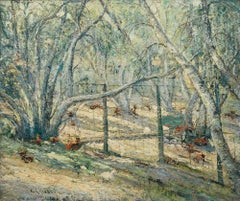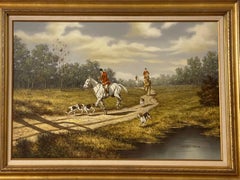Ernest Lawson Art
Ernest Lawson was born in Halifax, Nova Scotia in Canada in 1873. In 1888, he enrolled in classes at the Kansas City Art Institute. There, he studied with Ella Holman, whom he would later marry. Lawson realized that there were not many opportunities for artists in Kansas City, and 1890, he moved with his father to Mexico City. He worked as a draughtsman for an English engineering company and studied in the evenings at the San Carlos Art School. By 1890, he had saved enough money to move to New York, and he began studies at the Art Students League under John Henry Twachtman. Lawson developed his Impressionist style while studying under Twachtman and J. Alden Weir at their school in Cos Cob, Connecticut. He became devoted to landscape painting, and this interest remained unchanged throughout his professional life. In 1893, he traveled to France, where he studied in Paris at the Académie Julian under Jean-Paul Laurens and Benjamin Constant. During his stay in France, Lawson painted at Moret-sur-Loing, near the Fontainebleau forest, where he met Alfred Sisley, who along with Twachtman was the main influence on his work. In 1898, Lawson and his family moved to Washington Heights in Manhattan, and by the turn of the century, his work centered almost exclusively on views of this neighborhood. He and his family moved to Greenwich Village in 1906, and once there Lawson met William Glackens. Through this important and outgoing artist, Lawson became associated with a group of American artists in New York City, including Arthur B. Davies, Maurice Prendergast, William Glackens, Everett Shinn, Robert Henri, John Sloan, and George Luks. This group, who called themselves The Eight, held a well-publicized exhibition at the Macbeth Gallery in New York in February 1908. They were men of widely different tendencies and five of the eight artists were known best for their gritty urban scenes. However, common opposition to academicism, as well as an interest in the daily lives of the middle and lower classes bound all eight artists and the environment in which they lived. A committed landscapist, Lawson always began a work out of doors in the en plein air method. He did not create preliminary drawings but instead painted directly on the canvas. Lawson's work includes pure landscapes, foreign scenes, urban views and rural village scenes. His extremely rich and varied palette has been described as having a crushed jewel effect. Like the Impressionists, Lawson used intensely contrasting colors and rough impasto textures in his work and he had a particular interest in the effect of light on the surface of the landscape. After Lawson became associated with the artists of The Eight, his work became progressively less picturesque. Lawson created many winter landscapes during the first two decades of the 20th century and in them, the impasto and brushstrokes take on their structural significance.
Early 20th Century Ernest Lawson Art
Canvas, Oil
Early 20th Century Ernest Lawson Art
Oil
Mid-20th Century Realist Ernest Lawson Art
Canvas, Oil
Late 19th Century Victorian Ernest Lawson Art
Canvas, Oil
19th Century Naturalistic Ernest Lawson Art
Canvas, Oil
1840s English School Ernest Lawson Art
Oil, Canvas
1880s Naturalistic Ernest Lawson Art
Canvas, Oil
1860s Impressionist Ernest Lawson Art
Canvas, Oil
Late 19th Century Naturalistic Ernest Lawson Art
Oil, Canvas
2010s Impressionist Ernest Lawson Art
Oil
17th Century Old Masters Ernest Lawson Art
Oil, Canvas
Early 20th Century Impressionist Ernest Lawson Art
Canvas, Oil
1980s Post-Impressionist Ernest Lawson Art
Oil
Early 19th Century Realist Ernest Lawson Art
Canvas, Wood, Oil
1920s American Impressionist Ernest Lawson Art
Oil, Board
Early 1900s American Impressionist Ernest Lawson Art
Oil, Board
Early 20th Century American Impressionist Ernest Lawson Art
Oil, Board
Early 20th Century Ernest Lawson Art
Canvas, Oil





